Sub-ohm vaping is a somewhat controversial subject within the vaping community. But we like controversial topics so figured we would tackle it head-on and lay some demons to rest in the process.
Why is sub-ohm vaping controversial, I hear you ask. There’s a simple answer for that. If you exceed the amp limit of your battery, you could cause an explosion and possibly a fire. So if you do want to try sub-ohm vaping, read the guidelines in this article.
In a nutshell, sub-ohm vaping uses atomiser coils that have a lower resistance level than regulated mechanical mods. Sub-ohm vape mods work on the electrical principles of Ohms law, together with Joules law, thus use variable voltage/wattage that are less the one ohm. Standard e-cigarettes have a range between 1.5-3 ohms.
The benefit of sub-ohm vaping is that the electrical set-up increases the amount of power input to the coil thus creates more heat, more vapour and a richer burst of flavour. More vapour goes directly to the lungs rather than hitting the back of the throat. All in all, sub-ohm vaping offers a smoother vaping experience.
The danger is that if you don’t regulate the voltage, you risk blowing out the battery which could cause the entire Mod to explode. This will cause vapour! But definitely not the kind you want!
The good news is, the vaping market is well equipped with plenty of high powered devices that are regulated to deliver a consistent rate of power to the coil. Therefore, you can enjoy a sub-ohm experience and adjust the resistance to a level of your choosing.
How To Use Sub Ohm Vaping Devices
If you are going to try sub-ohm vaping, get clued up first. You don’t need a degree in electrical engineering, but you do need to know how to use your vaping device properly, how to manage the power supply to your battery and which e-liquids deliver a superior sub-ohm experience.
Let’s start with e-liquids. Juices that contain more vegetable glycerine (VG) than propylene glycol (PG) are better suited. The reason for this is because VG has a denser vapour production and as is less coarse on the throat than PG. Plus VG creates more vapour, in turn, this gives the cloud effect.
Sub-ohm vaping also allows you to cut back on the nicotine liquids that have a lower nicotine content – normally around 3mg/ml or under are perfectly suited to Sub-Ohm vaping.
So now, the technical stuff. Let’s start with the battery as this is a crucial element to vaping. And understanding the basics of powering a battery is vitally important when vaping sub-ohm so pay careful attention to the following.
First of all, don’t expose your battery to water, extreme heat or extreme cold. So basically, be careful not to leave your equipment laying around in environments that could potentially damage the battery.
Likewise, if your battery becomes damaged, dented, or the wrapper starts to give way, replace the battery before attempting sub-ohm vaping.
Furthermore, make sure your battery is an authentic model manufactured by a reputable brand. Sub-ohm Mods typically come with unprotected IMR or hybrid lithium batters which are safer for Sub-Ohm vaping than Li-ion LiPo or ICR batteries.
It is also beneficial to install a battery that can handle a high voltage. To be on the safe side, the battery should have a discharge rate of at least 30 watts and paired with a kanthal wire coil that has a resistance to 0.5 ohms.
Note: as you decrease the resistance to the coil, you increase the amp rate to the battery. It is therefore critical that you never exceed the batteries amp rate otherwise it will explode.
SUB-OHM Vaping Devices
There are three types of vaping devices you can use for sub-ohm vaping. Rebuildable dripping atomisers (RDA’s) also known as drippers; Rebuildable tank atomisers (RTA’s); Sub ohm tanks.
Newbies to sub-ohm vaping are advised to go with the latter; a sub ohm tank coupled with a box mod is the perfect introduction and will provide a safe sub-ohm experience and will help you get a feel for sub-ohm vaping without the risks.
Sub-ohm tanks are a good introduction to sub-ohm vaping. When you are more experienced, you might want to try RDA’s and RTA’s, but speak to someone that has experience rebuilding tank atomisers first.
You also need to invest in a vaping device that is suitable for sub-ohm vaping. A mechanical mod with that is well vented is preferable as larger vents allow more gases to escape should your battery fail. Never use an unvented mod to vape sub-ohm.
The vape mod should also have a low voltage drop so you don’t lose power travelling from your battery to your coil otherwise the sub-ohm experience is not as good. Mods with a one-piece tube, fixed position contact and magnetic switch turn in a superior performance.
Also, make sure to keep your vape mod clean. This includes the threads, vent holes, contacts and switch. If you notice the springs getting softer, don’t wait too long before replacing them.
If you want to try sub-ohm vaping, but not sure what is the best equipment to start with, get in contact or visit our Vape Shop Online and we’ll point you in the right direction.

